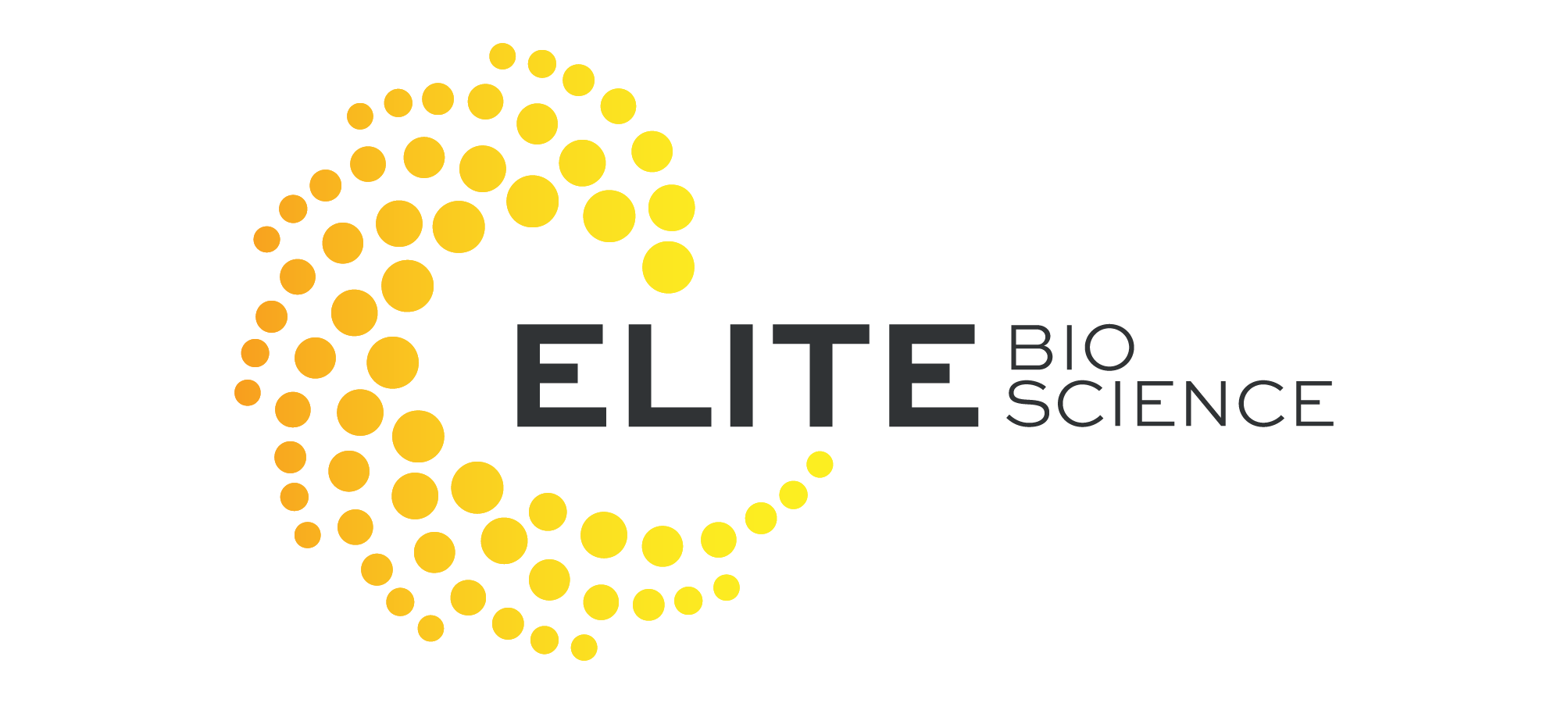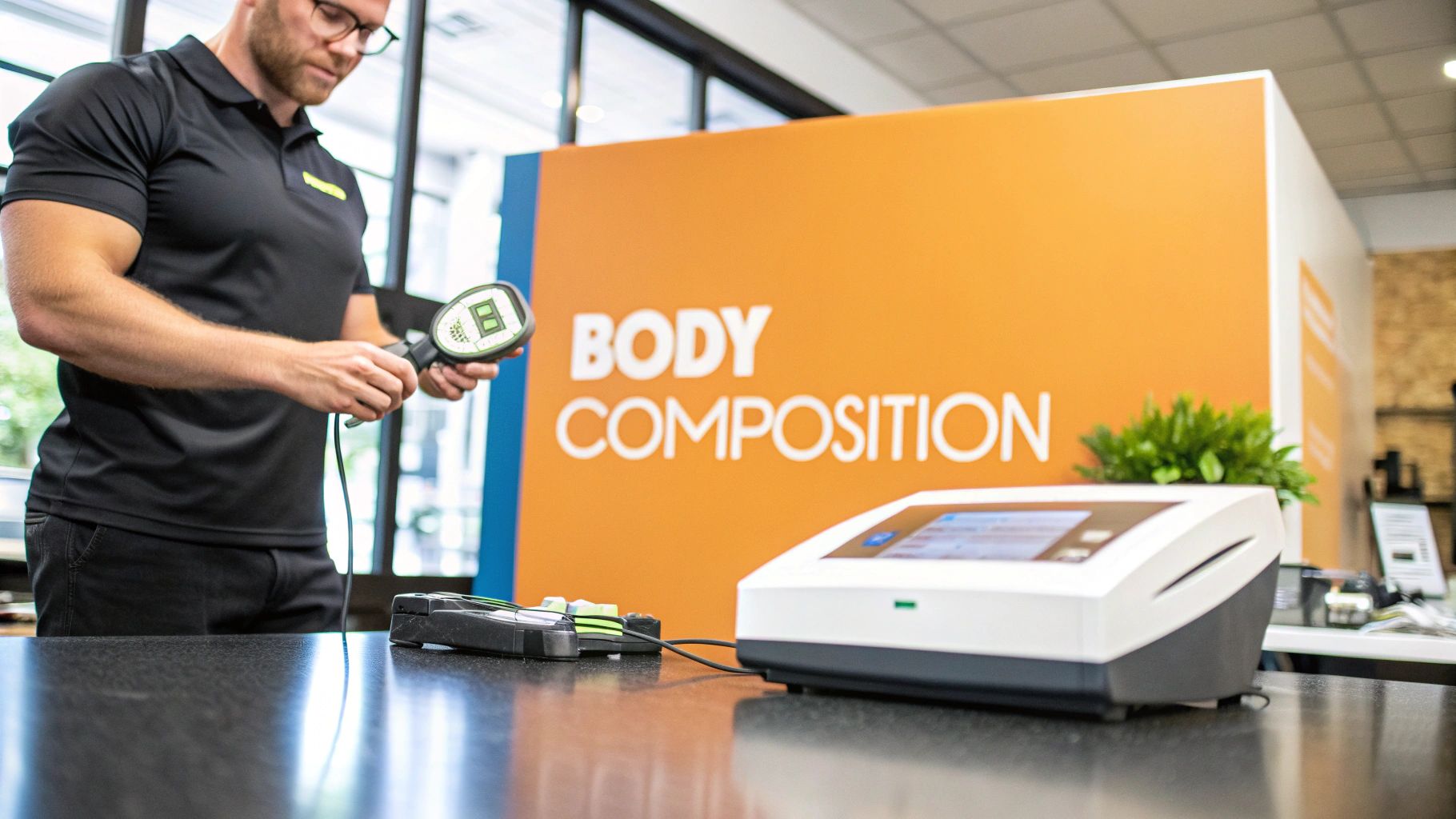Before you can even think about chasing elite performance, you have to get the basics right. I’m talking about mastering the fundamentals: intelligent training, performance nutrition, and strategic recovery. These three pillars are the bedrock of any successful athlete. They work together, building a durable foundation that lets you handle tougher workouts, recover faster, and see consistent gains.
Building Your Performance Foundation
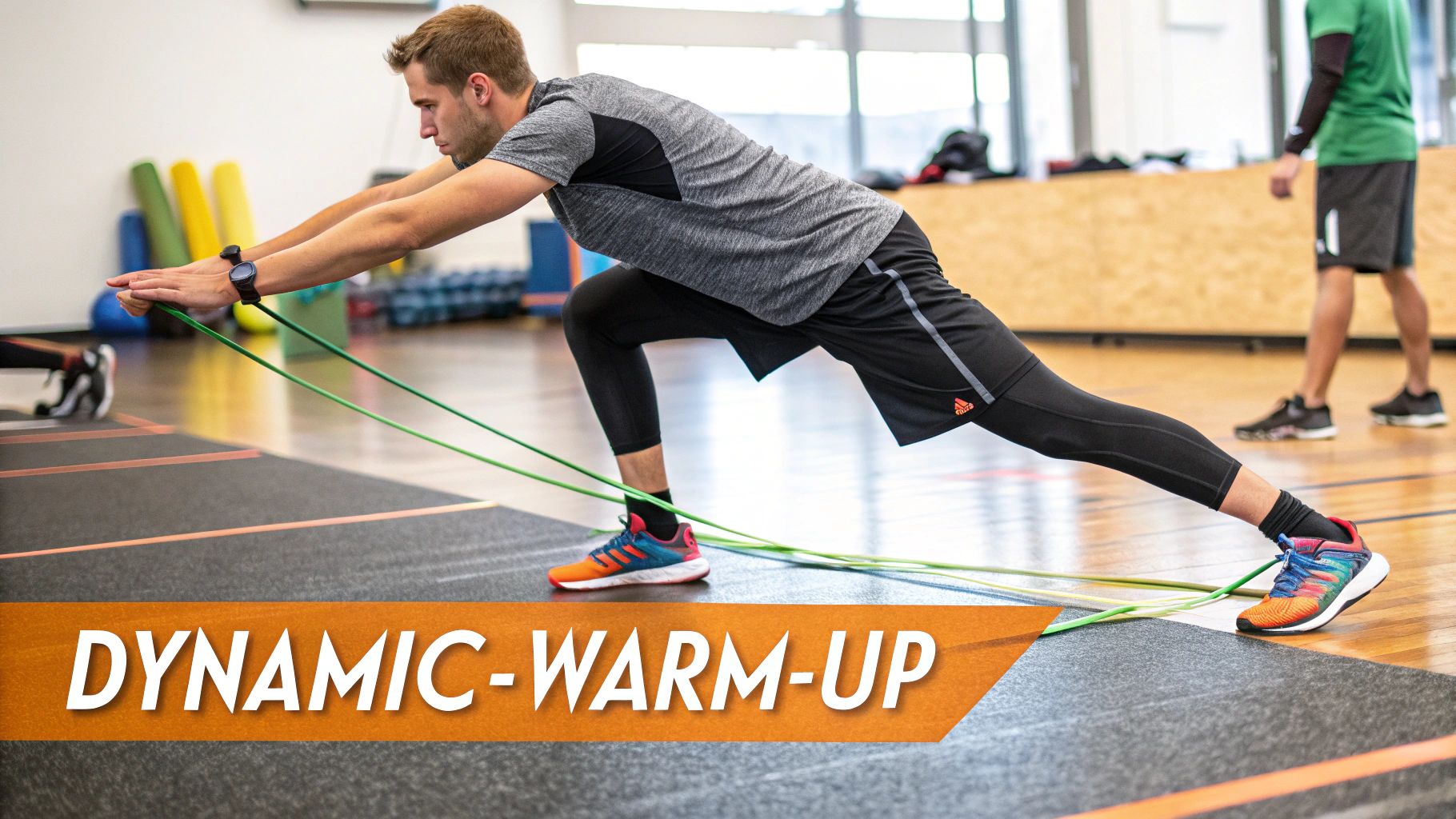
Look, everyone wants the flashy results, but you can't win the race until you've built a powerful engine. This first phase isn't about fancy bio-hacks or advanced supplements. It’s about hammering home the non-negotiable habits that every single bit of your future progress will stand on.
The journey starts with getting brutally honest with yourself. Where are you really at with your fitness? What are your glaring weaknesses? Answering these questions gives you a clear, no-nonsense starting line.
Establishing Your Baseline and Goals
One of the biggest mistakes I see athletes make is jumping into a cookie-cutter training plan they found online without knowing what they actually need. Real performance improvement is personal. You have to start by defining what winning looks like for you.
- Strength: Do you need to add 50 pounds to your squat to generate more power on the field?
- Speed: Is your goal to finally break that 5-second 40-yard dash?
- Endurance: Are you training for a half-marathon, or do you just want to avoid gassing out in the fourth quarter?
Setting sharp, measurable goals gives your training a purpose. Instead of just vaguely "getting better," you now have a target to aim for. This makes structuring your training not just easier, but infinitely more effective.
The most successful athletes are masters of the basics. They don't just go through the motions; they execute the fundamentals of training, nutrition, and recovery with relentless consistency.
The Three Core Pillars
Your entire athletic development rests on a simple but powerful tripod: how you train, how you fuel, and how you recover. If you neglect any one of these legs, the whole structure will eventually collapse under pressure. It's not a matter of if, but when.
To help you build a solid base, I've broken down the essentials in the table below. Think of it as a checklist to make sure you have all your bases covered before we dive into the more advanced strategies later in this guide.
Core Pillars of Athletic Performance
| Pillar | Key Focus Areas | Initial Action Steps |
|---|---|---|
| Intelligent Training | Periodization, Specificity, Progressive Overload | Assess current fitness, set 1-3 specific goals, and choose exercises that directly support those goals. |
| Performance Nutrition | Macronutrient Balance, Hydration, Nutrient Timing | Track your food intake for one week, ensure adequate protein and carbs, and drink water consistently. |
| Strategic Recovery | Sleep Quality, Active Recovery, Stress Management | Prioritize 7-9 hours of sleep, incorporate light stretching on off days, and schedule genuine downtime. |
Mastering these areas is your first and most critical mission. This foundational strength is what ensures that when you do add intensity or advanced therapies, your body is ready to adapt and excel—not break down.
Mastering Your Training With Smart Programming
Let’s get one thing straight: real progress comes from working smarter, not just harder. If you feel like you’re spinning your wheels, stuck on a plateau, or just plain burned out, it’s probably because you’re missing the most critical piece of the puzzle. You have to move beyond just lifting heavy or running far. It's about having a precise, intelligent plan.
The days of just showing up and winging it are long gone. Modern athletics requires a structured approach. Think of your training program as your roadmap—it’s what gets you from where you are to where you want to be. It dictates exactly what you do, when you do it, and how hard you go, ensuring every ounce of effort pushes you closer to your goal.
The Power of Periodization
Periodization is just a fancy word for organizing your training into specific blocks or cycles. Instead of doing the same old workouts week after week, you strategically manipulate volume (how much you do) and intensity (how hard you do it) over time. This is the secret to avoiding overtraining and making sure you peak at exactly the right moment for a competition.
There are a couple of popular ways to do this:
- Linear Periodization: This is the classic model. You start with high volume and low intensity, then gradually flip that ratio over several weeks or months. A powerlifter, for instance, might start a training block with sets of 10 reps, then move to sets of 8, then 5, and finally dial it in with heavy sets of 1-3 reps as the competition gets closer.
- Undulating Periodization: This approach keeps things fresh with more frequent changes. Within a single week, an athlete could have a heavy strength day, a lighter power day, and a moderate hypertrophy (muscle-building) day. This variety is fantastic for preventing boredom and hitting multiple athletic qualities at once.
The right model really depends on your sport, how long you've been training, and your timeline. A marathon runner’s plan will look totally different from a basketball player’s, but the core principle of planned variation is universal.
Aligning Training With Your Goals
The principle of specificity is simple but profound: you get better at what you actually train. If you’re a sprinter, spending all your time on long, slow jogs is a waste. It won't make you faster off the blocks. Your training has to directly mimic the demands of your sport.
Start by breaking down the key physical requirements of your discipline. Does your sport demand explosive power? Sustained endurance? Quick changes of direction? Your exercise selection has to reflect that. A football lineman needs to live in the squat rack and on the bench press to build raw strength, while a tennis player should be focused on rotational power and lateral agility drills.
Your efforts in the gym must have a clear purpose. Every exercise, set, and rep should be a deliberate step toward building the specific physical qualities your sport demands. Random workouts produce random results.
This process flow chart gives you a visual on how to structure a foundational strength program that’s actually built around your specific goals.
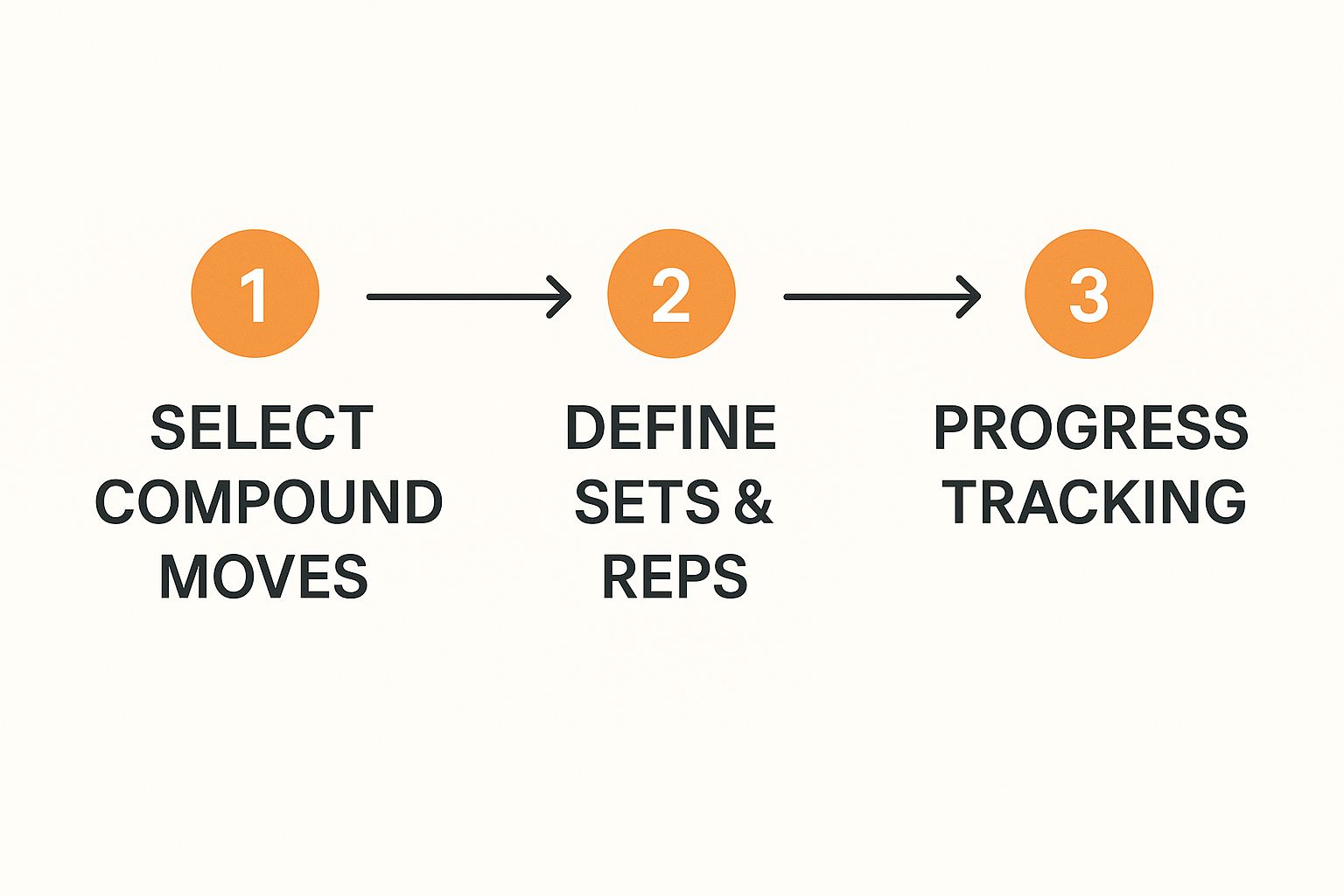
As the infographic shows, a winning program always starts with selecting foundational compound movements, moves on to defining specific training volumes, and depends on constant tracking to guide your next steps.
Tracking Progress for Continuous Improvement
What gets measured gets managed. If you’re not tracking objective data, you’re just guessing. Seriously. Data-driven training isn't just for the pros anymore; it’s essential for any serious athlete who wants to get better and stay healthy. Wearables that track things like heart rate variability, power output, and energy expenditure are becoming standard. Modern coaches are using this data to spot weaknesses and create laser-focused training plans.
At the bare minimum, you need to be tracking these things:
- Training Log: Write down your exercises, sets, reps, and weights for every single session.
- Performance Metrics: Log your run times, jump heights, or scores in your skill drills.
- Subjective Feelings: Use a simple 1-10 scale to rate your energy levels, sleep quality, and muscle soreness each day.
This data lets you see trends over time. It tells you when you're ready to push harder (that’s progressive overload) and, just as importantly, when you need to back off and recover. Some advanced athletes even explore other avenues for recovery and growth. For those curious about emerging options, you can check out our guide on peptides for muscle growth to understand what's on the horizon.
Ultimately, smart programming fueled by good data is what turns your hard work into real, repeatable success.
Fueling for Peak Output with Performance Nutrition
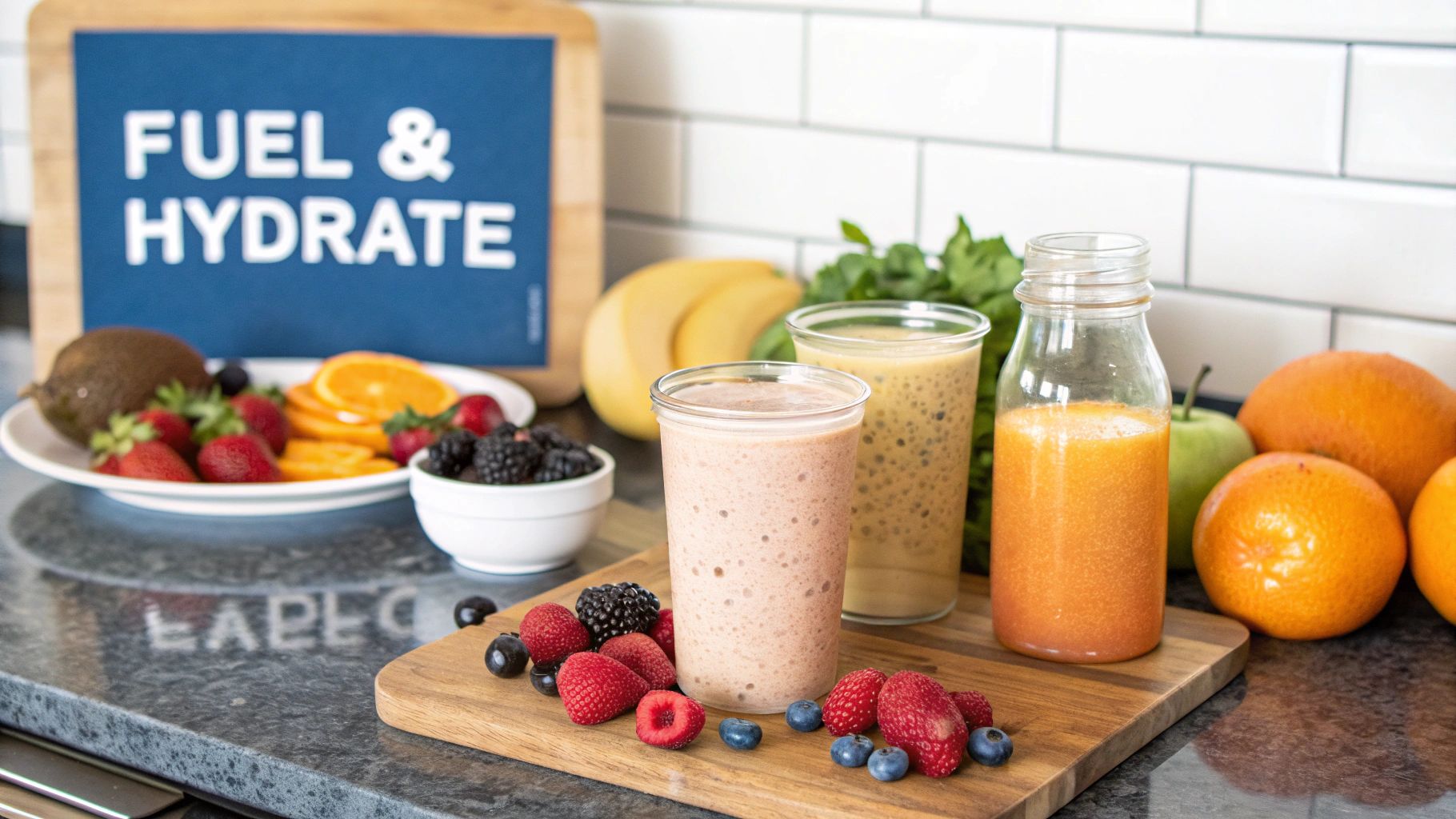
Let's get one thing straight: you can't out-train a bad diet. Think of your body as a high-performance engine. You can have the most advanced training program and the best recovery tools, but without the right fuel, you’ll never hit your true potential.
Performance nutrition isn't about miserable, restrictive dieting. It’s a strategic framework for giving your body exactly what it needs to train hard, recover fast, and dominate when it counts. Your approach to food is one of the most powerful levers you can pull. It dictates your energy, your ability to repair tissue, and your overall resilience. It’s time to stop seeing food as just "calories" and start viewing it as functional fuel.
Macronutrient Timing for Energy and Repair
The concept of what you eat is inseparable from when you eat it. Timing your macronutrients—your carbs, proteins, and fats—around your training sessions can radically change your results. This isn't about being neurotic with a stopwatch, but about being intentional.
Carbohydrates are your body’s go-to energy source. They provide the glucose your muscles store as glycogen for that explosive, on-demand power you need. That "wall" you hit mid-workout? That's what happens when your glycogen stores run dry. Loading up on carbs before a session tops off your tank, ensuring you have the fuel to perform at a high intensity from start to finish.
After the workout, the mission changes. This is where combining carbohydrates with protein creates a powerful one-two punch for recovery. The carbs rush to replenish your spent glycogen, while the protein delivers the essential amino acids needed to kickstart muscle repair and growth. This simple strategy significantly cuts down on post-exercise fatigue and gets you back in the game faster.
A huge mistake I see athletes make is fearing carbohydrates. For anyone training seriously, strategically timed carbs from whole-food sources are not the enemy. They are the key to unlocking higher intensity and faster recovery.
The Critical Role of Hydration and Electrolytes
You can have a perfect diet, but if you're dehydrated, your performance will tank. It’s that simple. Even a slight drop in hydration—as little as 2% of your body weight—can crush your endurance, increase how hard an effort feels, and impair your cognitive function. Water is the foundation of every single metabolic process in your body.
When you sweat, you're losing more than just water. You're also losing critical electrolytes like sodium, potassium, and magnesium. These minerals are essential for nerve signaling and muscle contractions. That debilitating mid-game muscle cramp? An electrolyte imbalance is often the culprit.
For intense or long training sessions, especially in the heat, water alone often isn't enough. This is where a quality electrolyte drink becomes a non-negotiable tool. It helps maintain fluid balance and keeps your muscular system firing on all cylinders.
Micronutrients That Support Your System
While macros provide the gas for the engine, micronutrients—vitamins and minerals—are the spark plugs and engine oil that keep the whole system running smoothly. They're the unsung heroes of performance, crucial for everything from energy metabolism and immune function to bone health and oxygen transport.
Think of them as the support crew for your body. They don't provide the raw energy, but they make sure everything else works correctly.
Essential Micronutrients for Athletes
- Iron: Absolutely critical for producing hemoglobin, which carries oxygen to your working muscles. Low iron leads directly to fatigue and a nosedive in your work capacity.
- Vitamin D: A major player in bone health, immune function, and muscle performance. A surprising number of athletes are deficient, especially those who train primarily indoors.
- Magnesium: Involved in over 300 enzymatic reactions, including energy production and muscle relaxation. It’s also lost through sweat, making it easy to become depleted.
- B Vitamins: This entire group of vitamins is essential for one main job: converting the food you eat into usable energy.
A diet packed with a variety of fruits, vegetables, lean meats, and whole grains will cover most of your micronutrient bases. However, due to the intense demands of training, some athletes may need to supplement specific nutrients—but only after consulting with a healthcare professional to address confirmed deficiencies and truly improve athletic performance.
Accelerating Recovery to Prevent Burnout
Your biggest performance gains aren't made in the gym—they happen when you rest. It's a hard truth for many athletes, but training breaks your body down. Recovery is what builds it back up, stronger than before. Without a deliberate recovery protocol, you’re not just leaving results on the table; you're on a fast track to burnout.
Upping your athletic game means getting serious about what you do in your downtime. This isn’t just about taking a day off. It’s about building an active, strategic system that repairs muscle tissue, rebalances your hormones, and sharpens your mental edge. Skipping recovery is like trying to build a skyscraper without letting the concrete set between floors. Sooner or later, it’s going to collapse.
The Science of Quality Sleep
Sleep is the most powerful performance-enhancing tool you have, and it's completely free. It’s during these critical hours that your body gets down to its most important repair work. Growth hormone, essential for muscle repair and growth, peaks during deep sleep. On the flip side, poor sleep spikes cortisol—a stress hormone that actively breaks down muscle and kills your recovery.
Think of it this way: just one night of bad sleep can tank your reaction time, cloud your judgment, and sap your power output. Getting 7-9 hours of high-quality sleep every night is non-negotiable. It’s the foundation for every other recovery method. You can take all the ice baths and foam roll until you’re blue in the face, but without enough sleep, you're fighting a losing battle.
To lock in your sleep hygiene, try these simple moves:
- Stick to a consistent bedtime and wake-up time, even on weekends.
- Make your bedroom a cave: as dark, quiet, and cool as possible.
- Power down all screens (phones, TVs, tablets) at least an hour before bed. The blue light messes with your body's melatonin production.
Active Recovery and Mobility
Rest days don't have to mean being glued to the couch. Active recovery is all about low-intensity movement that gets blood flowing to your tired muscles, helping to flush out metabolic junk and deliver fresh, oxygenated blood for repair. This is a game-changer for reducing delayed onset muscle soreness (DOMS) and keeping you feeling fresh.
A solid active recovery session can be simple:
- Light Cardio: A 15-20 minute walk, easy spin on a bike, or a gentle swim.
- Foam Rolling: Spend 5-10 minutes hitting major muscle groups like your quads, hamstrings, glutes, and back. This helps release knots and improves tissue quality.
- Dynamic Stretching: Focus on movements that take your joints through their full range of motion—think leg swings, arm circles, and torso twists.
This approach does more than just soothe sore muscles. It actively improves your mobility and flexibility, which are crucial for preventing injuries and executing movements with clean, efficient form. You’re not just recovering; you're pre-habbing for your next big session.
"I always speak with athletes about the importance of what they're doing in their down time. Improving athletic performance is dependent on establishing a healthy routine where the athlete hydrates regularly, fuels their body appropriately, and optimizes sleep and recovery." – Mark Murphy, DPT
Advanced Recovery Modalities
Once you have your sleep and active recovery dialed in, you can start exploring more advanced tools to find that extra edge. These methods aren't magic bullets, but when used correctly, they can give your recovery speed a noticeable boost.
- Cold Water Immersion: Ice baths can be a shock to the system, but the science is there. The cold causes your blood vessels to constrict, which helps flush metabolic waste out of your muscles. As you warm up, the vessels dilate, bringing a rush of nutrient-rich blood back to the tissues for repair.
- Sauna Therapy: The heat stress from a sauna has been shown to improve endurance and fire up the production of heat shock proteins, which play a key role in cellular repair. The increased blood flow also works wonders for muscle recovery.
- Compression Technology: Gadgets like compression boots or sleeves use rhythmic air pressure to massage your limbs. This process helps boost circulation and cut down on swelling, making it a favorite among pros for post-workout recovery.
Integrating these tools smartly is key. For example, a sauna session can be great on a lighter day, while an ice bath might be best saved for after an absolutely brutal workout. For those nagging aches or minor injuries, you might need more targeted support. Our in-depth guide on shifting towards a pain-free life with specialized recovery stacks offers a closer look at these advanced options. Building a resilient recovery system is your ultimate insurance policy against overtraining, making sure you’re always ready to hit it hard again.
Leveraging Technology for a Competitive Edge

In the world of high-performance sports, raw talent and hard work will always be the foundation. But today, the real secret weapon—the thing that separates the good from the truly elite—is data. Using technology is no longer a luxury reserved for professional teams; it's a powerful and accessible tool for any dedicated athlete looking to find a genuine advantage.
This isn't about drowning in a sea of numbers. It’s about zeroing in on the specific metrics that directly lead to better performance and a lower risk of getting sidelined. Modern wearable devices have evolved far beyond simple step counters, now offering incredible insights into how your body is really handling the stress of your training.
Turning Data Into Smarter Decisions
The true power of technology is its ability to make the invisible, visible. It gives you cold, hard feedback that your gut feelings might miss entirely. Devices like heart rate monitors and GPS trackers offer an unfiltered look at your physiological output during any given session.
Instead of just guessing how tough a workout was, you can see exactly how much time you spent in specific heart rate zones. This is huge. It ensures your recovery days are actually promoting recovery and that your hard days are truly moving the needle. It replaces guesswork with certainty, allowing you to make surgical adjustments to your training plan.
Your body keeps an objective score, whether you track it or not. Technology simply gives you the ability to read that score in real-time, empowering you to make adjustments before you’re sidelined by overtraining or injury.
Wearable tech and AI have opened up a new frontier in athletic optimization, offering a level of personalization and injury prevention we've never seen before. Take the GPS-tracking vests you see on professional athletes—systems like the Catapult Vector track precise metrics like speed, total distance, changes in direction, and overall workload. This real-time data allows coaches and athletes to fine-tune training programs to an individual's physiological response with stunning accuracy.
Key Metrics That Actually Matter
Getting lost in data is a real risk, so it’s critical to focus only on what gives you the most actionable information. For any athlete looking to sharpen their approach, a few data points are absolute game-changers.
Heart Rate Variability (HRV): This is a measurement of the tiny variations in time between each heartbeat. A higher HRV is generally a sign that your nervous system is well-rested and ready to take on a tough workout. On the flip side, a consistently dropping HRV is a major red flag, often showing up before you even feel the first signs of overtraining.
Training Load: This metric puts a number on the total stress from your workouts, usually calculated from a mix of volume and intensity. Keeping an eye on your training load helps you apply progressive overload safely, making sure you’re building fitness without digging yourself into a hole of fatigue.
Recovery & Sleep Scores: Many wearables distill a mountain of complex data into a simple score, often from 0-100. This gives you a quick, daily snapshot of your readiness to perform. A low score might be the signal you need to swap that high-intensity interval session for some active recovery, heading off a potential problem before it starts.
Using AI to Pinpoint Weaknesses
The next evolution in sports tech involves AI-powered platforms. These systems analyze your performance trends over weeks and months, spotting patterns you’d never catch on your own. They can flag specific weak points—like a drop in explosive power late in a game—and even highlight subtle biomechanical changes that might signal an impending injury.
This proactive approach is a massive shift. You’re no longer just reacting to problems after they happen; you’re anticipating them. By staying on top of these powerful tools, you can train smarter, recover faster, and stay in the game longer. For a deeper look into this subject, check out our guide on the top sports hacks and emerging trends in athletic performance. It’s all about using every advantage at your disposal.
Exploring Advanced Performance Therapies
So you've dialed in your training, your nutrition is on point, and your recovery is meticulously planned. But you're still hitting that stubborn wall. It’s a frustrating place to be, and for any serious athlete, it’s natural to wonder what else is out there.
This is where the conversation turns to the frontier of sports science—advanced medical therapies. This isn't about finding a shortcut. It’s about intelligently exploring every possible avenue to break through limitations, always under the strict guidance of a qualified medical professional.
Let’s be crystal clear: these aren’t over-the-counter supplements. They are significant clinical interventions that demand a full medical workup, a prescription, and constant monitoring by a physician. This is where medicine and peak performance truly intersect, requiring a responsible, educated approach.
Medically Supervised Optimization
Sometimes, a performance plateau has less to do with your workout split and more to do with your underlying physiology. This is where a doctor can step in to identify and correct genuine deficiencies that are holding you back.
Hormone optimization is a perfect example. Testosterone Replacement Therapy (TRT) has gained a lot of attention, but its true purpose is to help men with a clinical diagnosis of low testosterone. When prescribed and managed by a doctor, the goal is simply to restore hormone levels to a healthy, optimal range, which can have a major impact on energy, recovery, and strength.
Similarly, intravenous (IV) nutrient therapy is a tool for rapid repletion after intense exertion. A grueling event can drain your body of essential vitamins and minerals. An IV drip can deliver a high-concentration dose of things like Vitamin C, B-complex vitamins, and magnesium directly into your bloodstream, bypassing the digestive system for nearly 100% absorption and faster recovery.
These therapies are clinical tools designed to fix a problem, not just boost a healthy system. They should only be considered after a confirmed medical need is identified through bloodwork and a consultation with a healthcare professional.
The Landscape of Peptide Therapies
Peptides are one of the most exciting areas of performance science right now. These are simply short chains of amino acids that act as precise signaling molecules, telling specific cells what to do. Think of them as targeted text messages for your body.
Researchers are looking into certain peptides for their potential to accelerate healing and recovery. For instance, peptides like BPC-157 have been studied for their ability to support tissue repair in ligaments, tendons, and muscles—areas notoriously slow to heal.
This interest in new frontiers makes sense when you look at the big picture. In many sports, performance improvements are stagnating despite better training methods. A landmark study tracking over a century of athletic data found that world records in many events have hit a plateau. This suggests we're nearing the limits of what conventional methods can do. You can read more about the research on performance plateaus to see how we're bumping up against these physiological ceilings.
Navigating Regulations and Ethics
Venturing into advanced therapies takes more than just a doctor's prescription—it demands a deep understanding of the rules of your sport. For any competitive athlete, this part is non-negotiable.
Here’s your action plan for navigating this complex area safely and ethically:
- Work With Medical Experts: Your first and most important step. Find a doctor who specializes in sports medicine or hormone therapy. Self-prescribing is not only incredibly dangerous but can cause serious, long-term health problems.
- Check Regulatory Bodies: Before you even consider a therapy, you must check the prohibited list from your sport's governing body, like the World Anti-Doping Agency (WADA). A substance can be perfectly legal to prescribe but still be banned in competition.
- Health Comes First: The ultimate goal of any therapy should be to support your long-term health, not just to chase a short-term performance boost at any cost.
The point here is to give you an overview of what's being explored at the highest levels of sport. Consider this an educational map of the possibilities, not a list of recommendations. Any decision to improve athletic performance with these tools must start and end with expert medical guidance.
Your Questions, Answered
When you're pushing for peak performance, questions are going to come up. It's only natural. Here are some of the most common ones we hear from athletes, with straightforward answers to help you navigate your journey.
How Long Does It Take to See Significant Athletic Improvements?
This is the big one, and the honest answer is: it depends. Your starting point, your sport, and—most importantly—your consistency are the biggest factors. If you're just getting started, you'll likely feel a noticeable difference in your strength and energy within 4-8 weeks of following a structured plan.
For a more experienced athlete, the game changes. Chipping away at a personal record or improving a specific metric like your 40-yard dash time might take a full competitive season of focused effort. The key is to trust the process. Patience isn't just a virtue here; it's a mandatory part of getting real results.
Can I Just Train Hard and Ignore My Diet?
You could, but it would be the fastest way to sabotage all your hard work. Think of it this way: your training is the signal that tells your body to adapt and get stronger, but your nutrition provides the actual building blocks to make it happen.
Your body can't build muscle, replenish energy stores, or repair damaged tissue without the right fuel. A world-class training program paired with a poor diet will always lead to mediocre results, period.
It’s a non-negotiable part of the equation.
Are Expensive Wearable Tech Devices Necessary to Improve?
They're powerful tools, but they absolutely are not necessary to improve athletic performance. Getting the fundamentals right—consistent training, high-quality sleep, and smart nutrition—will always give you the biggest bang for your buck. Nail those first.
That said, modern wearables can be incredible performance accelerators. They offer objective data on things like your Heart Rate Variability (HRV), which can help you make smarter calls on when to push hard and when to back off. Think of them as a valuable accessory that adds another layer of insight, not a prerequisite for success.
What Is the Single Most Important Factor for Recovery?
While a solid recovery plan has many moving parts, all the scientific research and real-world evidence point to one clear winner: sleep.
It’s during deep sleep that your body gets down to its most important repair work. This is when it releases crucial hormones like growth hormone, regulates stress hormones like cortisol, and hardwires the new motor patterns you learned in training. If you can only dial in one aspect of your recovery, make it a non-negotiable 7-9 hours of quality sleep every single night.
Ready to explore advanced therapies to support your performance goals? Elite Bioscience provides medically supervised access to high-quality peptide, hormone, and vitamin therapies tailored to your needs. Discover how our programs can elevate your health and performance by visiting https://elitebioscience.co.
